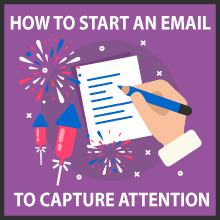
Everyone wants their emails to be seen, read and answered 100% of the time. But few sales reps know how to start an email to achieve it.
That’s why you see so many articles written about email outreach. Everyone wants to solve the riddle. But there are a lot of things to get right before you can send a perfect email. Most of them are very specific to the situation you’re in.
So I can’t promise you that this article is the solution.
What I can promise though is that you’ll be one step closer to better emails. And here’s why.
The do’s and dont’s of how to start an email
We often talk at length about what to include in your email. Subject lines are obviously very important. The way you follow up on your messages (which you should do regularly, by the way). Or even your email signature — every little detail has an impact on whether your message will be read.
(Sidebar — we’ve been outlining how to improve your cold email game for quite some time here at LeadGibbon. So be sure to subscribe, if you haven’t already!)
That said, what we rarely talk about is how to start an email. And what I mean is the first sentence of your message, and how it can make or break your cold email strategy.
So today, we’re going to do that. Here are some of the things you should (and shouldn’t) do to start an email like a pro. Let’s begin!
Highlight the reason for sending an email
You should always try to find a reason for writing an email that is relevant to each prospect. It’s important to make the effort to research your prospects before the initial cold email.
But that research can’t help you if you don’t put it front and center.
Here’s an example. Imagine that your prospect has mentioned a relevant problem on Twitter. You have an article on your blog that explains how to solve it. What’s the best way to start a conversation around it?

Keep your email short and sweet. Try to explain why you’re sending a message in the opening sentence. By the end of the first paragraph, your prospect should clearly understand what is it that you want.
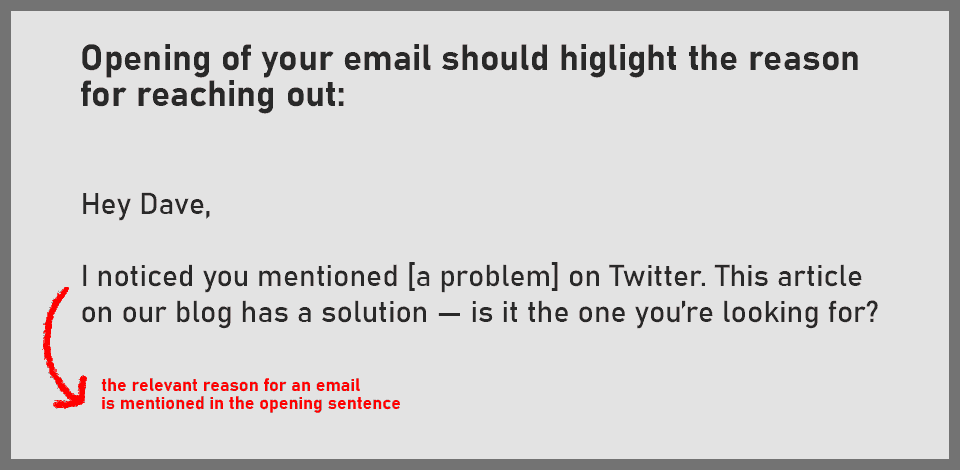
Essentially, the two examples above are the same message. They use the same reason for reaching out (a tweet). Share the same content with a prospect (an article). And they want them to take the same action (open the link).
But the first email is longer and less specific. Which means that the prospect spends more mental energy deciphering what you want. Which means that they are that less likely to take immediate action.
As I always say, make it as easy as possible for your prospect to make the decision to open and read your email. If you start with a relevant reason, you’re, minimizing the risk of being ignored. So cut the fat.
Speaking of cutting the fat…
Don’t explain who you are
I’ve seen a lot of sales (or marketing) emails. They usually begin with a variation of the same routine: an introduction.

I get why people believe it’s a good idea to introduce yourself before everything else. They think it’s polite. Maybe they think their position will impress the recipient. Plus, everybody else is doing it, so it must make sense, right?
It doesn’t.
Look at it from your prospect’s point of view. You get an unsolicited email, from somebody you never met. Unless the sender is working for a big company, their name or title won’t tell prospects anything.
So why would you waste your precious opening line on something that has no value?

Your message and email signature explain who you are just fine. Provided, of course, that you formatted the email signature correctly.
On second thought, scratch that. A formal introduction in the opening sentence does tell your prospect something. It tells them that you’re sending a sales email before they even open it.
And most sales emails suck. So your lead has yet another reason to delete and forget your message without reading it through.
Mention somebody you and your prospect both know
Mentioning mutual acquaintances helps capture your prospect’s attention. People want to have somebody they trust help them make important decisions.
(I explained why it works in our article on persuasive techniques.)
If you can’t find a relevant reason for getting in touch with somebody, make it a priority to find a referral. An email that opens with a familiar name will be that much more persuasive.
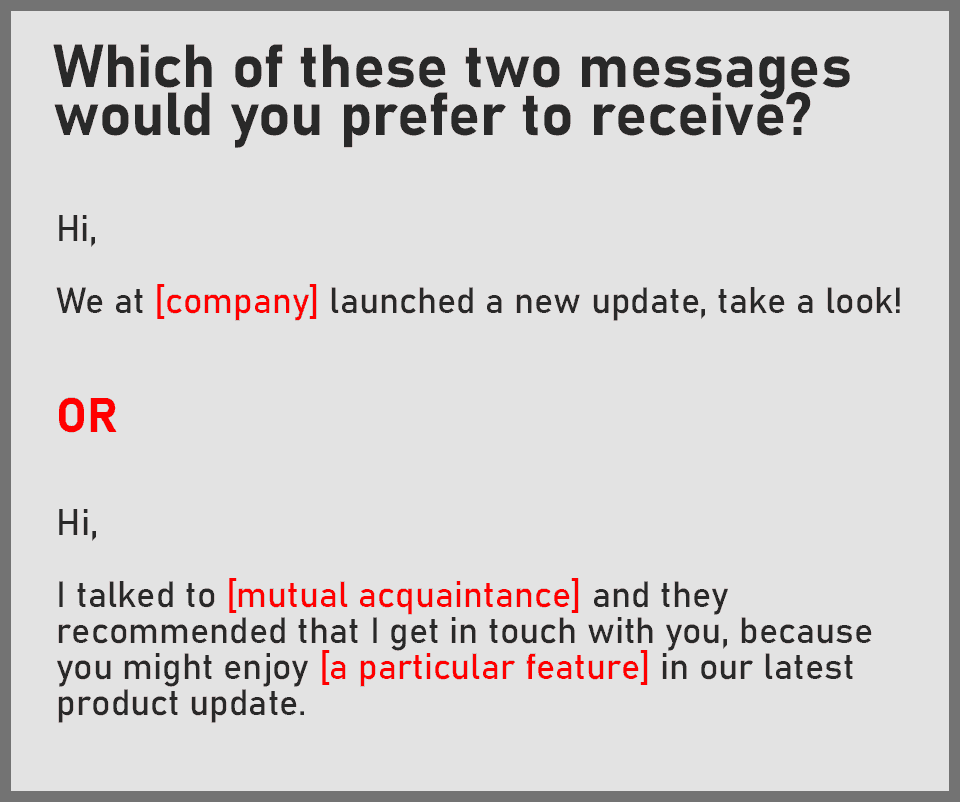
Asking for a referral from existing customers is absolutely worth it. Especially considering that 89% of sales reps never ask for one (HubSpot).
By the way, Sales Navigator can help you find prospects who know your existing customers. Make it a habit to check whether you have common connections before writing an email.
Don’t force a friendship
‘How are you?’, ‘What’s up?’ or ‘How was the weekend?’ seem like polite ways to start a conversation. But these phrases are too generic to be perceived as actual friendliness.
Best case scenario, your prospect will mindlessly skip over it. Worst case scenario? You’ll make your email seem more robotic and forced.
It’s especially bad if you start with a ‘polite’ question… only to immediately proceed to a non-personalized sales pitch:
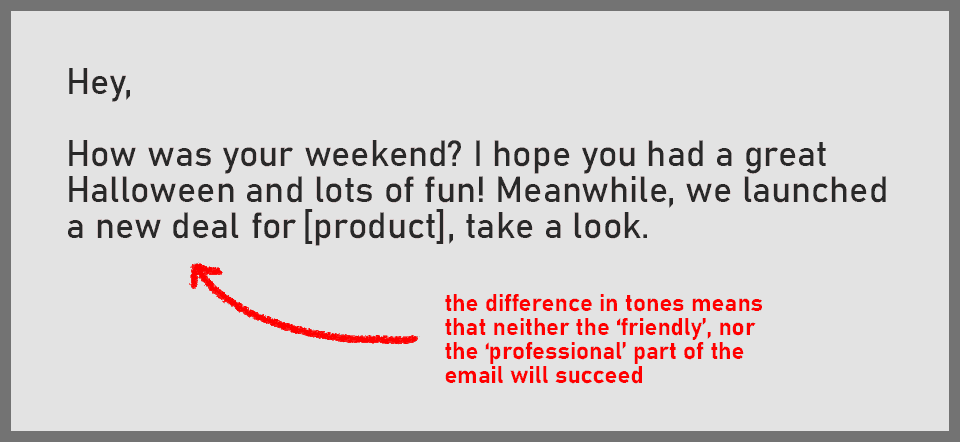
Look, relationship selling is important. But generic How are you’s are not the way to achieve it!
My advice? Just drop the niceties. There’s a better way to show that you’re interested in your prospect. Ask them about concrete projects they are working on right now!
An email that opens with ‘Hey Steven, how’s the new blog post going?’ will get my attention. An email beginning with ‘Hey, what’s up bro?’ goes straight into the bin.
Trust me, it’s obvious when the friendliness is forced.
Cut sales clichés
Various sales clichés are a mainstay in cold email outreach. They might feel like something that makes your message more polite or professional. But clichés hurt its significance.
Here are some of the most popular sales clichés I could remember and what they actually look like to your prospect.
(By the way, don’t hesitate to share the clichés you encounter in the comments section.)

In reality, sales clichés often fail to resonate with the recipients. Sales reps who use ‘a quick question’ in their emails have five times less than the average open rate (Yesware).
Now, is that really a risk worth taking?
On the enduring importance of learning how to start an email
A good way to understand the importance of the opening sentence is to think about emails like novels. A subject line is like a title on the book’s cover — it should attract the prospect’s attention and make them open an email.
But a great opening sentence is what makes people read your email.
Don’t believe me? Believe Stephen King. He spends months picking the right opening sentence for each of his novels.
You can make an argument that novels and cold emails are different… But they are not that different. Both need to grab the reader’s attention, intrigue them and make them respond!
In the case of novels, that response is emotional. With cold emails, the response you’re seeking is a solid Yes.
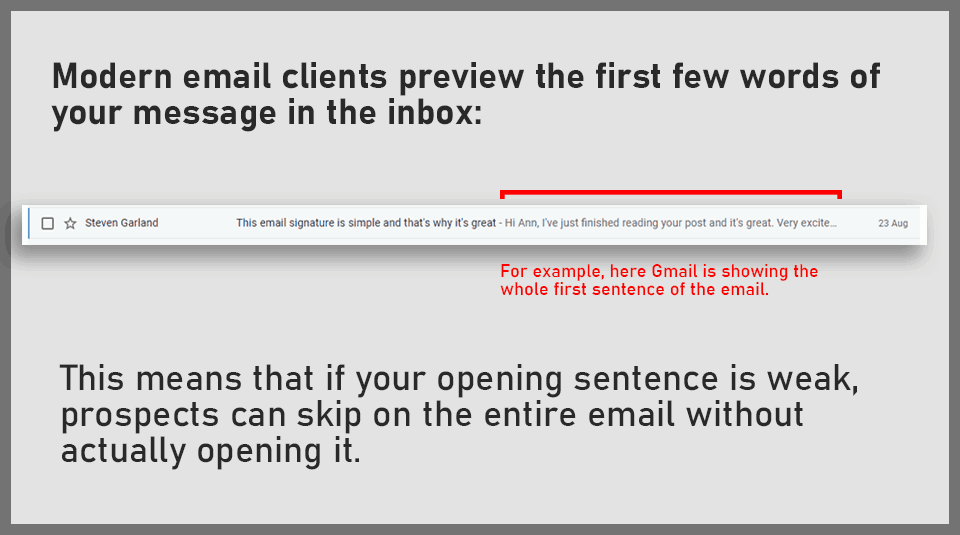
Last but not least, don’t forget that modern email apps show the opening of the email alongside the subject line. This applies to both desktop and mobile.
When my inbox is full, I use these snippets to estimate whether an email is worth my attention. I’m willing to bet that your prospects are doing it, too. Use the first 4-6 words of your email to write something intriguing or useful. In my experience, this approach greatly improves your chances of getting a positive reply.
Conclusions
Want a prospect to engage with your email? Then capture their attention in your opening sentence.
I hope that the tips above will help you come up with messages that are impossible to skip. There is no reason why sales emails should not be every last bit as thrilling as the latest Stephen King novel!
But let’s get back to you. Maybe you have your own way of how to start an email that works for you? Don’t hesitate to share your own tips, mistakes, and experiences in the comments section below!

Leave a Reply